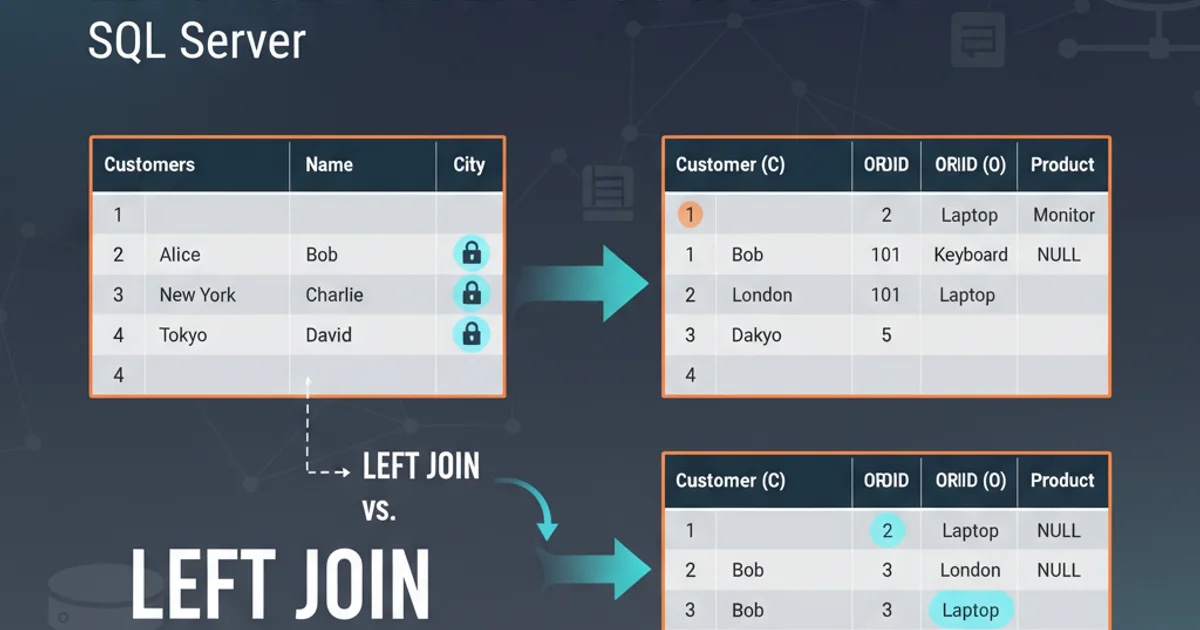LEFT JOIN vs. LEFT OUTER JOIN in SQL Server
Categories:
LEFT JOIN vs. LEFT OUTER JOIN in SQL Server: Understanding the Nuances

Explore the subtle differences and practical implications of LEFT JOIN and LEFT OUTER JOIN in SQL Server. This article clarifies their identical functionality and provides examples for effective use.
When working with SQL Server, you'll frequently encounter various types of JOIN clauses to combine rows from two or more tables. Among the most common are LEFT JOIN and LEFT OUTER JOIN. A recurring question for many SQL developers, especially those new to the language, is whether there's any functional difference between these two. This article aims to clarify this point, demonstrating that in SQL Server, they are indeed synonyms and behave identically.
The Core Concept of a LEFT JOIN
A LEFT JOIN (or LEFT OUTER JOIN) returns all rows from the left table (the first table mentioned in the FROM clause) and the matching rows from the right table. If there is no match for a row in the left table, the columns from the right table will contain NULL values. This type of join is crucial when you want to ensure that all data from one primary table is included in your result set, regardless of whether corresponding data exists in another related table.
erDiagram
CUSTOMER ||--o{ ORDER : places
ORDER ||--|{ PRODUCT : contains
CUSTOMER {
int CustomerID PK
varchar Name
varchar Email
}
ORDER {
int OrderID PK
int CustomerID FK
date OrderDate
}
PRODUCT {
int ProductID PK
varchar ProductName
decimal Price
}Entity-Relationship Diagram illustrating Customer, Order, and Product tables.
LEFT JOIN and LEFT OUTER JOIN: Identical in SQL Server
In SQL Server, the keywords LEFT JOIN and LEFT OUTER JOIN are completely interchangeable. The OUTER keyword is optional and does not alter the behavior of the join. This is a common source of confusion because other join types, like INNER JOIN and FULL OUTER JOIN, explicitly use INNER and OUTER to denote their distinct behaviors. However, for LEFT JOIN and RIGHT JOIN, the OUTER keyword is merely syntactic sugar.
SELECT
c.CustomerID,
c.Name,
o.OrderID,
o.OrderDate
FROM
Customers AS c
LEFT JOIN
Orders AS o ON c.CustomerID = o.CustomerID;
Example using LEFT JOIN to retrieve all customers and their orders.
SELECT
c.CustomerID,
c.Name,
o.OrderID,
o.OrderDate
FROM
Customers AS c
LEFT OUTER JOIN
Orders AS o ON c.CustomerID = o.CustomerID;
Example using LEFT OUTER JOIN, which produces the exact same result as LEFT JOIN.
As you can see from the examples above, both queries will return the same result set: all customers from the Customers table, and any matching orders from the Orders table. If a customer has no orders, the OrderID and OrderDate columns will show NULL.
LEFT JOIN and LEFT OUTER JOIN are identical in SQL Server, it's good practice to choose one and stick with it for consistency within your codebase. Many developers prefer the shorter LEFT JOIN for brevity.When to Use a LEFT JOIN
A LEFT JOIN is particularly useful in scenarios where you need to:
- Retrieve all records from a primary table: For instance, listing all employees, even those not assigned to a department yet.
- Find unmatched records: By adding a
WHEREclause to check forNULLvalues in the right table's columns, you can identify records in the left table that have no corresponding entries in the right table. This is often used for data integrity checks or finding missing information. - Generate reports: When you need a comprehensive list of items from one category, augmented with optional details from another.
SELECT
c.CustomerID,
c.Name
FROM
Customers AS c
LEFT JOIN
Orders AS o ON c.CustomerID = o.CustomerID
WHERE
o.OrderID IS NULL;
Finding customers who have not placed any orders using LEFT JOIN and a WHERE clause.
LEFT JOIN and LEFT OUTER JOIN being identical is specific to SQL Server and many other relational database management systems (RDBMS). However, always consult the documentation for your specific RDBMS if you are working with a different database system, as conventions can vary.